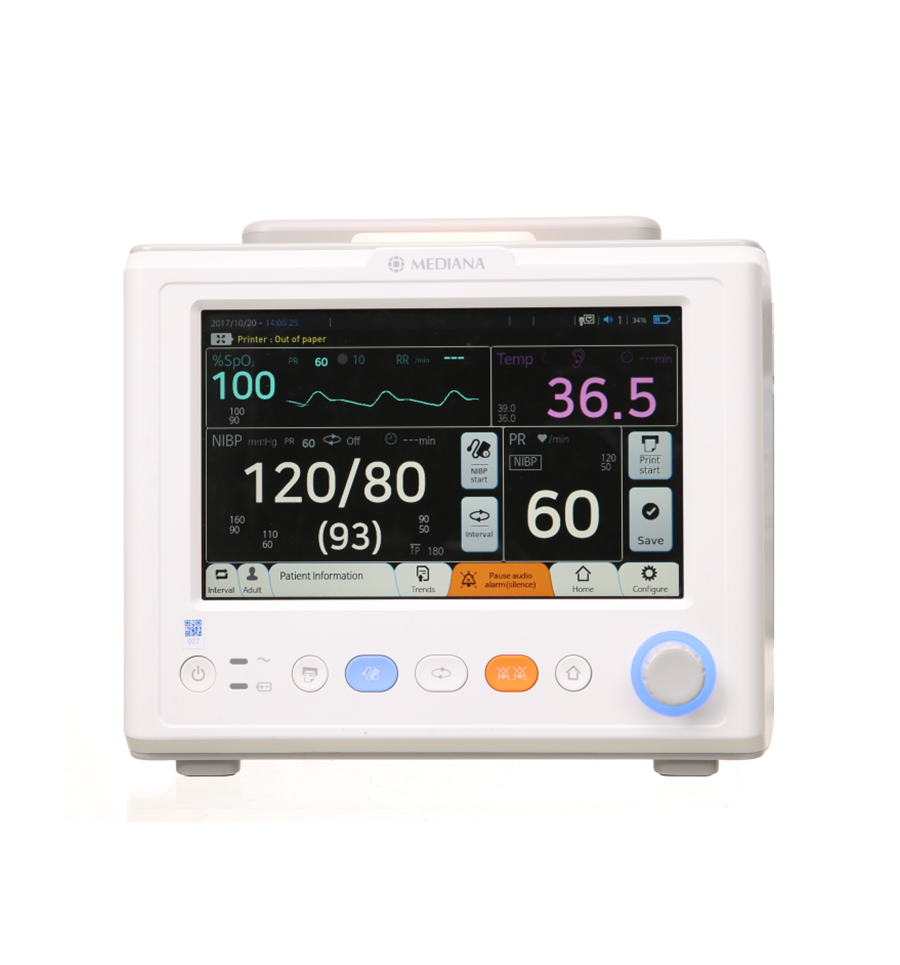
PRODUCTS
VITAL SIGN MONITOR
-
V20
-
V10
V20
Comprehensive Solution for your needs in Critical
and Intermediate Care
- High Resolution 8” LCD TOUCH SCREEN
- NIBP Technology from AND
- SpO2 Technology from Nellcor™ OxiMax™
- 3 Li-ion Battery Options: 2 / 5 / 8 Hours.
- HL7, ASCII Data Output for HIS / EMR
- Barcode Scanner support for Patient ID
- Connectivity: USB, LAN and Wifi
- Internal Data Storage: over 3,000 patient data
- EWS (Early Warning Score) Function
- Compatible with wired / wireless EMR
Intended Use for the V20/V20a
The monitor is intended to be used to monitor noninvasive blood pressure (NIBP) - systolic, diastolic and mean arterial pressures, functional arterial oxygen saturation (SpO2), pulse rate (PR) and temperature (Temp) for adult, pediatric (including neonatal) patients in all areas of a hospital and hospital-type facilities. Monitor users should be skilled at the level of a technician, doctor, nurse or medical specialist. The vital sign monitor V20 is only suitable for single measurement but V20a is suitable for single as well as continuous measurement.
Note: Hospital use typically includes such as general care floors, operating rooms, special procedure areas, intensive and critical care area, within the hospital. Hospital-type facilities include ambulance, physician office-based facilities, sleep labs, skilled nursing facilities, surgical centers, and sub-acute care centers.
Note: The medically skilled and trained user can be clinicians like doctors and nurses who know how to take and interpret a patient’s vital signs. These clinicians must take direct responsibility for the patient’s life. This can include care-givers or medically trained interpreters who are authorized under the appropriate clinical facility procedures to support patient care. Any inappropriate setting, especially the alarm limit or alarm notification settings, can lead to a hazardous situation that injures the patient, harms the patient, or threatens the patient’s life. This equipment should only be operated by trained users who can adjust the settings of the vital signs monitor.
V10
- Large, bright and Easy-to-read Numercial Displays
- AND NIBP Module (compatible with other NIBP modules after certification)
- SpO2 options Mediana SpO2 or Nellcor Oximax
- 2 Temperature Options:
- - Covidien Genuis 2 : Fast & accurate with 1~2sec’ data acquisition
- - Alaris Turbo : Self-test, auto-calibration, most used temp solution for emergency medicine oral, rectal, axillary application
- 3 Li-ion battery options: 2, 4, 6 hours (NST)
- HL7, ASCII, Excel Data Output for HIS / EMR
- Trend Dump for Monitoring Mode and Service Mode
- Barcode scanner support
- USB, LAN and Wifi connectivity
- Internal Data Storage: Min. 1000 patient data
- Data Management Software for trend review
Intended Use for the V10
Note: Hospital use typically includes such as general care floors, operating rooms, special procedure areas, intensive and critical care area, within the hospital. Hospital-type facilities include physician office-based facilities, sleep labs, skilled nursing facilities, surgical centers, and sub acute care centers
Note: The medically skilled and trained user can be clinicians like doctors and nurses who know how to take and interpret a patient’s vital signs. These clinicians must take direct responsibility for the patient’s life. This can include care-givers or medically trained interpreters who are authorized under the appropriate clinical facility procedures to support patient care. Any inappropriate setting, especially the alarm limit or alarm notification settings, can lead to a hazardous situation that injures the patient, harms the patient, or threatens the patient’s life. This equipment should only be operated by trained users who can adjust the settings of the vital signs monitor.


